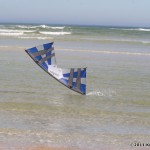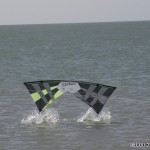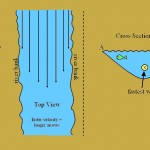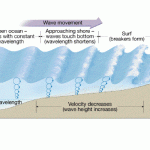Where wind meets water, flying through the barrier…
First, a couple of big disclaimers…
One – although I’ll be sharing some diagrams and references, this is NOT a scientific article by any stretch of the imagination (although I’m sure we’ll hear about that side too), I just figured I’d share some of the knowledge and experience I’ve accumulated as a water-dabbling dual and quad line pilot during the past 21 years.
Two – understand that your average kite is not made for regular contact with the wetness or mass of water and can lead to broken spars, a damaged sail or the eventual breakdown in your fabric or the coating, some glues, some styles stitching, the colors, or even mildew if you store your kite damp.
Much of what I’ll be talking about below relates to quad, dual and single line alike, but I have far more experience taking Revolutions (quad line) underwater so most of this will be shared with a Rev in mind… I’ll try to refer to dual line when I see the opportunity to do so, but you should be able to translate most of this over to other kite types yourself – a lot of it is universal.
Ultimately, I encourage you (the reader) to add your own comments, experiences and challenges with any type of kite, or any technical expertise you might have to offer on the subject by replying below – it’s a very cool, broad topic and I know folks would benefit from additional discussion.
First, something to WET your appetite!
(water flying is 0:00 to 2:28 in the video)
Safety and respect, the golden rules.
Let’s face it, a good water environment isn’t usually custom-tailored for kitefliers and many times it’s a venue that is obviously dedicated to something other than kite flying… One of my favorite haunts in Portland is a little dock on the Willamette River that is used regularly by dragon boat or kayak folks, and I always give them right of way, my kite is pulled in before they dock, lines out of the way entirely, or if the wind is blowing the right way I just move down to a respectful distance and keep the kite mellow while they finish up.
Don’t fall in!
Seriously, it’s an exercise in awareness – don’t underestimate what can happen if the wind drops suddenly or you find your dock is swaying heavily from a boat’s wake… Set an internal alarm, and if it gets dicey, just STOP where you are, let the chips fall!
Bottom line – you can almost always reel your kite in (especially on shorter lines), but trying to control too many variables and dragging your butt out of a pond may not give the best impression for kitefliers… That, and all we need to do is tick off ONE kayaker for the gig to be up when dock management comes down to see what is bothering their boaters.
Safety, respect, can’t say it enough.
Upkeep, ride it hard but don’t put it away wet!
Before you go plunging in, it will pay to understand the basics of kite care after water flying…
Just a few steps toward caring for your kite after water use will greatly extend the life and aesthetics of your sail.
When packing after a water fly I leave my kite unrolled with the sail laying loose, or if I’m packing it on a train or something, I’ll roll the kite up as loosely as possible for storage on the way back… With many colors of ripstop, especially brighter ones (even PC31), the color can sometimes bleed across to another color in the sail (red to white is a common one)… Rolling it up for 20 minutes should be alright though, if you’ve got to hoof it somewhere.
Once I get the kites back to base camp, I give them a good clean water rinse in the shower before letting them dry out… If they’re a bit mucky, I try a little rub with my palms or fingertips, perhaps a soft cloth and a very diluted mild hand soap if they’re especially dirty.
Kites all clean, I assemble them without tensioning the wingtips (add loose standoffs on a dual line) and leave them against the wall (not stacked) in a semi-warm room overnight… The idea is to open the sail up so there are no folds, letting it breathe and dry out fully without being stretched too tight.
Aerodynamics vs Hydrodynamics
With kites we traditionally look at the Airfoil and Aerodynamics for design and control principles, but underwater we might look at the Hydrofoil and Hydrodynamic aspects (fluid dynamics)… I’m sure there’s a whole scientific comparison but for the purpose of this article, I’ll just cover the tangible comparisons I’ve noticed as a flier.
Moving water (liquid) and air (gas) work very similarly against a sail surface, although water is SIGNIFICANTLY heavier and slower.
The effect of gravity is reduced due to the physical resistance of the water, as well as the time it takes to move and displace liquid as opposed to air.
Kites tend to generate WAY more pull and resistance against water, making them more prone to breakage.
Inertia and momentum have nearly no effect on an underwater kite, due to the lack of mass and weight.
For a heavily oversimplified example, take something like a large tupperware lid and submerge it in a large tub of water the same way you might imagine doing with a kite…
Try pushing against the water with the flat of the lid and notice the heavy resistance…
Try it again with half of the lid above surface, and notice the interplay between the heavy, slow moving part in the water and the slightly unbalanced, free-swinging portion above…
What we’re getting a feel for here, is the difference in mass and pressure between air or water against your kite.
Calm vs Current vs Waves!
Standing water rocks slightly, waves roll and currents travel… Each style of water flying gives a totally different experience, both in terms of the potential for play and the possible pitfalls for kite and pilot – it pays to have a basic respect and understanding of this.
With ponds and lakes (calm water), keeping a light tension in the lines, you’ll may feel a submerged kite sway or rock slightly… This is more or less static water flying, with you doing most of the work loading or unloading water pressure (drive) in the sail.
Without a doubt, this is the easiest and safest water venue in which to learn or play.
Currents are a different game altogether, as the mass is in movement all the time, more or less in one direction… The three ways to reduce the water pressure in your submerged sail is to (1) walk in the direction of the water flow, (2) release one edge of your kite so a smaller area of it is resisting the oncoming water, or (3) get your kite out of the water as quickly as possible.
River flow
Moving water presents a danger due to the constant mass and pressure (possible breakage or other damage).
The trick with moving bodies of water is that they generate exponentially more pressure than the same MPH of wind… If water mass at a speed of 4 mph is hitting the full face of your (average sized) kite, there’s a good chance you’re going to blow out your frame or sail, or you could possibly even break the lines and lose your kite downstream altogether.
Depending on the strength of the current, you can also be pulled into the water if you don’t release in time… But you exercise awareness and discretion, currents can certainly add new dynamics in terms of interacting with or “riding” in the flowing liquid.
A few years back, we were flying on Tarrapin Point, a major drop off for the Niagara Falls… To do a tip drag, all we had to do was keep the kite in one spot with a tip grazing the fast-moving water.
Talk about a volume of water in motion!!
Of course, one inch too much and the whole kite package would have been violently sucked out of our hands, never to be seen again… No second chances there – simple words to the wise.
With wave scenarios, I think a lot of folks believe the water is traveling forward – which isn’t exactly true… In my experience, waves of small to medium size are more like an energy wave moving water forward, back, up and back down, so if a submerged kite stays upright in a wave it might travel a maximum of 10′-15′ around a central point.
You may recall, waves make floating boats bob up and down instead of pushing them along. This is because the waves travel through water; they do not take the water with them. As a wave arrives it lifts water particles. These travel forward, then down and back so that each particle completes a circle. Circling movements of particles near the surface set off smaller circling movements below them.
Wave movement
It’s weird for sure and a bit terrifying, but if you can simply keep tension in the lines by moving along with the displacement, the mass of the liquid can keep your kite from falling over underwater even amidst this wide circular movement.
Of course, this is HARD CORE… Not for the light of heart, wave flying is very dangerous to kites – especially if your kite isn’t at the right position inside the wave, as the weight/mass of a breaking wave can literally fold and snap one or more spars and run the risk of corresponding sail damage.
The rush is amazing though, if you’re willing to put your kite on the line!
==
My most interesting personal experience with waves was in Crescent City a few years ago when the wind was coming from the land… With a fairly decent breeze (6-8mph), tall enough waves (5-6 feet) and my B-Series Rev, I was actually able to do the following:
- Land at the foot of a forming wave, allowing the kite to sink in.
- At the moment of submersion, the kite is moved by the water – back (away from the pilot), up and then forward.
- As the wave is reaching full form, the Rev rides up the inside of the curl headed toward the break.
- Timing correctly, I was able to break out through the top of the wave and fly away.
Obviously I needed the right conditions to pull this off and a constant focus on line tension, control and kite position (within and through the wave)… But believe it or not, I actually succeeded several times and only got caught by the breaking wave once.
The one time I got caught though, whew, it was ugly… Thought for sure that kite was a goner, I lucked out.
Surface contact
Prior to actually plunging your kite in, it might be prudent to try some basic water contact instead… Equally or more fulfilling than flying underwater, working the surface is often a more beautiful and surreal experience.
Tip touches
Just what it says, try some simple touches – with a Rev you can just hover in your most stable position and slowly touch the very surface of the water, or with a dual line delta, try your best landing method and be ready to launch away the moment your wing tip(s) touch the water.
Expand on this as you get more comfortable, try holding it long enough for a couple inches worth of tip or tail to actually sink in and pay special notice the slight difference in how your kite responds when it’s touching the water at various depths.
Tip drags
 Alright, this is a very similar concept as simple touches except we add two important components:
Alright, this is a very similar concept as simple touches except we add two important components:
- Keeping some sort of drive in the sail and allowing the kite to fly in one direction.
- At the same time, compensating for the drag on whatever part of your kite is touching the water.
Example… If you’re flying in a left to right straight line across the window, the kite is pretty stable… Now let’s say we’re doing the same pass left to right and our right wingtip makes contact with the water, that liquid has a pulling effect on the kite and will make it want to turn in that same direction.
In that example, I’m dragging my right wing and the kite is being pulled that way… To compensate, I’m just applying a little extra tension on my opposite turn to balance out against the drag and stay above surface.
This video link is time-cued to show an long tip drag example – note how the water pulls down on the kite.
When you’re learning this, starting from a hover might be the safest way… Dip a tip in and slowly start to fly forward, and notice how the water contact makes the kite turn when it’s in motion… Play with the balance, try not to use jerky inputs, grade your inputs on and off as smoothly as possible.
“Plucking”
 This is one of my absolute favorite things to do with a Rev on water… Basically, it involves making a brief stab with the tips or edge of the Rev so the kite sinks in about 1-2 inches, then in a nearly continuous motion, launches back into the air.
This is one of my absolute favorite things to do with a Rev on water… Basically, it involves making a brief stab with the tips or edge of the Rev so the kite sinks in about 1-2 inches, then in a nearly continuous motion, launches back into the air.
This video link is time-cued to show a plucking example – note the tips down landing and relaunch at 1:54 and 2:00.
The effect is a quick “grab and scoop” of water that uses the surface impact of a sharp water landing to make launching back out easier… In the split second your kite makes contact, it’s still disrupting the surface, the water hasn’t taken hold of it yet… In that same split second, the kite is relatively free to launch and still has the sail pressure needed to do so.
Going underwater – nose or tail first?
Now, just getting in the water is a sticky proposition… First and foremost, if your kite doesn’t stay in a “flight orientation” (relative to the flier), it’s a pretty safe bet that you’ll be dragging your kite out by the lines.
The key is to land the kite in such a way that it settles in and submerges in the right position so that the water can load up, keeping your kite in the correct orientation with managed line tension.
Nose (or leading edge) first
Going in nose first is by far the most dramatic and interesting to me as a flier, but I think it also requires more exact timing and a functional understanding of your transition from air to water.
The tricky part here I think, is to keep the kite from falling over while it submerges… You need the right line tension upon impact, so that there’s enough to “fly” (or drive) fully into the water, but not enough tension to cause the kite to fall over while you do it.
Also CRITICAL, going in nose-first should only be done if you think you have enough clearance to the bottom in order to make your underwater turn so that your kite can fly back out.
Tail (or trailing edge) first
Especially easy with a Rev but also possible with a dual line delta, landing on slow moving water isn’t much different than doing so on land… You’ll feel resistance (like the ground), but with a softer impact and the possibility of sinking.
What makes this simpler (especially when learning), is that the kite is already pointed the right way for recovery and you don’t so much need to focus on steering or true underwater “flight” to get it back out.
Power and speed
Exponential increase of power…
Unlike wind which spills fairly well around (or off) fast moving kites, full submersion of a full size sport kite in a water current of just 3-4 mph or more can represent a potentially unstoppable amount of pull for the average human body and a high potential for frame breakage or sail stretch/damage… Don’t underestimate this, or it will bite you on the butt when you’re not looking.
Exponential decrease of speed..
Water flying is R-E-A-L-L-Y S-L-O-W.
I’ve said it before, I’ll say it again – the two main keys are PATIENCE and full awareness of the TENSION in all of your lines.
Once you’re underwater, both FLIGHT and CONTROLS all in slow motion and should stay that way until you’re more than halfway back out of the water.
Steering underwater
First thing to remember, and I can’t say it enough… Underwater “flight” is super SLOW compared to being airborne.
Second thing – when you change your inputs, it takes a couple of seconds for the water pressure to shift/settle into a new place on the kite… Patience is a virtue, along with keeping a keen awareness of the tension in all your lines.
If ANY line is totally loose, that part of the kite is totally out of control and can easily cause the kite to flip or misdirect.
When making turns or rotations (all totally possible), remember that most kites (except for the Rev) will require a much larger turning radius… Combined with the incredible slowness, it’s easy to think all is lost partway through when in fact, all is well.
Another factor to consider at all times if the possibility of hitting bottom… If you “fly” deep enough underwater, your kite will eventually encounter whatever is down there, including mud, silt, sand, even rocks, trees or other pointy objects.
Flying blind
Now unless you’re lucky enough to fly in Bermuda or some other tropical venue, you’ll probably be dealing with less than optimal visibility once your kite goes totally under… Not only are you flying blind, but you’re dealing with a less than familiar “flight” dynamic.
Learning the controls takes time, pure and simple, but for dealing with the “blindness” I pay special attention to what I CAN see – the lines going from handles to water surface… As your kite rotates underwater, you’ll see the visible portion of your lines rotate as well and once you’re familiar enough with this and keep track from the start, you should be able to know which way your kite is pointing.
What to do if you lose control
This could happen in any number of scenarios…
- Bad landing (nose or tail), causing the kite to flop over into an uncontrollable position.
- Loss of tension in one or more lines, allowing the kite to flip roll up underwater.
- Kite is broken, badly enough to be uncontrollable.
In these situations you’ve got a limited number of choices…
- Pull your kite in by the lines, hand over hand, until you can reach it.
- Pray and burn incense, maybe the water deities will return your prize flier.
If you do end up having to actually reel your kite in on long lines, I strongly suggest you consider these aspects:
- If you just pull line in and pile it up, you’re likely to run into otherwise avoidable tangles.
- If you walk along the edge of the water, you may be able to keep your line straight, but watch out for bushes, etc.
- My preferred method, actually use a winder from the handles, you can wind it all in and keep your lines straight.
In a worst case scenario, you may have actually impaled or stuck your kite on some unseen underwater evil… Aside from going back to prayer and incense, you can either savagely try to pull it off (dangerous), or you can also try alternating controlled pulls between the different lines to see if you can rock the kite loose.
If you’re firmly stuck on the bottom though, it may be time for scuba lessons… And don’t say we didn’t warn you!
Back into the sky
We’ve looked at a lot of the dynamics involved in playing with the water, but it’s all for nothing if you can’t get your kite back out!
First thing to understand, it takes a little time to actually get into a good launch position, again – it’s all SLOW.
The kite not only moves very slowly, but it’s holding water (added weight) for quite a while after it reaches air… The trick more or less, is to get 65% (or preferably more) of your kite above the surface before you try to pump and launch into the air.
- Doing this, more than half of your kite has the opportunity to shed some water (added weight) before trying to fight gravity.
- The resistance of the water is at the bottom, lighter air resistance is at the top, so launching too early or late could cause the kite to fall over in the water, making it nearly impossible to relaunch without dragging it out by the lines… Getting most of your kite out of the water allows air pressure to be the majority influence, enabling a clean launch.
- Once in the air, flying straight up may be very difficult due to the added weight of the water – sometimes angling the nose or leading edge downward for a moment can be useful, just so gravity helps to get some drive in your sail.
- Another trick once in the air, is to give the kite a really good shaking through your hand controls… Not so much as to flip or lose control of your kite, but enough to “shake water off like a dog” which will further reduce your weight and make flying easier.
It’s going to be right about this time you’ll also start to reevaluate the overall weight or strength of your kite relative to the kind of flying you’ve just accomplished… But seriously, great job – if you’ve read this far it’s safe to say that you are Tako Kichi (“kite crazy” in Japanese) and will no doubt have all sorts of funny and cool stories to share with us here in the near future.
A few more visuals to stimulate your imagination…
Take care, but fly outside the box!
A few reminders…
- Respect the venue and non-kiting activities.
- Suspend disbelief, water flying is 100% possible.
- Be safe, take care of yourself and others nearby.
- Experiment, push those boundaries and be creative.
- Share your experience with others, pay it forward.
==
That’s all I have for you this time around, my deepest hope is that you’ll take something away from this article and come up with some new exciting things for the rest of us to play with… Keep it going, innovation and play is what kiting is all about!
Ride the waves,
John Barresi





